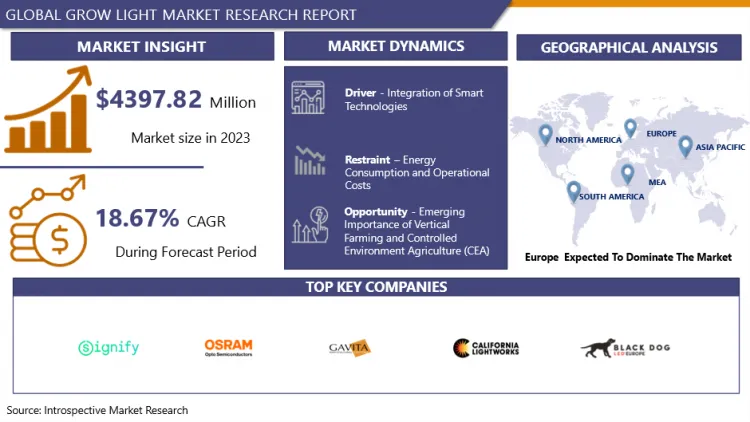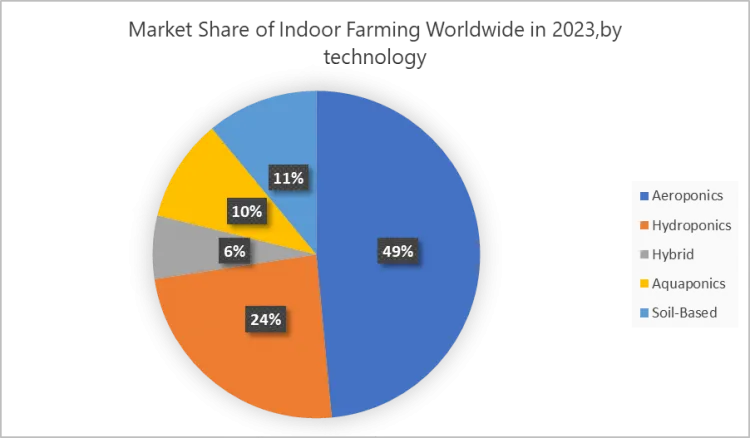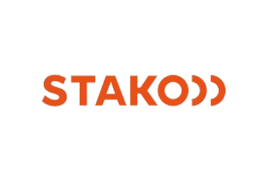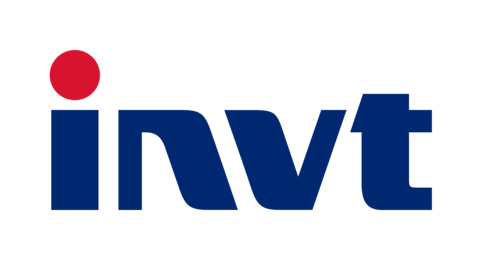Grow Light Market Synopsis
Grow Light Market Size Was Valued at USD 4397.82 Million in 2023, and is Projected to Reach USD 20526.08 Million by 2032, Growing at a CAGR of 18.67% From 2024-2032.
A grow light is a artificial light used to stimulate photosynthesis and speed up plant growth in the absence of sunlight. It is available in LED, fluorescent, HID, and incandescent varieties. Grow lights imitate the sunlight to supply plants with the essential light spectrum for their development. By altering the spectrum of light, they are able to meet the specific requirements of plants. These lights enhance various growth stages for plants by imitating different light cycles, resulting in higher yields of vegetables and fruits.
- Using grow lights is necessary when there is not enough sunlight in winter or when there is not enough space for an outdoor garden. Urban farming, vertical cultivation, and environmentally conscious fruit and vegetable production are driving the expansion of the market. Rising world population leads to a growing need for urban agriculture.
- Vertical farming in multi-tiered structures such as warehouses and high-rise buildings is also driving the expansion of the market. Grow light imitates natural daylight, boosting plant health, growth, and yield. LED and plasma lighting can increase crop availability throughout the entire year. Increasing knowledge about alternative agriculture as a result of limited fertile land and a growing population is fuelling the industry's need for grow lights.
- Indoor farming uses controlled environment agriculture technology to enable year-round crop production, increasing productivity and shielding plants from extreme weather conditions through artificial light and fertigation. Government regulations are promoting advanced technology like LED grow lights for indoor agriculture due to their energy efficiency and ability to improve plant growth. These lights offer benefits such as longer life, lower temperature, and government rebates.

Grow Light Market Trend Analysis
Integration of Smart Technologies
- Smart growth lights in the Internet of Things come equipped with sensors and connectivity that allow for the real-time monitoring of light, temperature, humidity, and CO2 levels in order to optimize the conditions for plant growth. Smart grow lights can adjust brightness levels based on predetermined schedules or sensor data, reducing the reliance on manual intervention, improving efficiency, and ensuring consistent illumination for plants. Insights from data collected by intelligent grow lights offer valuable information on the growth, health, and performance of plants, assisting growers in optimizing conditions for increased yields.
- Customizable smart grow lights can be tailored to adjust both the light spectrum and intensity based on the specific crop and growth stage, leading to improved crop quality and productivity. Smart grow lights utilize energy monitoring to maximize power efficiency, adapt light intensity according to natural light and plant growth phase, and minimize energy usage. Intelligent LED lights decrease waste of resources and maintain ideal plant conditions, supporting sustainability in farming by maximizing resource efficiency.
- Intelligent grow lights provide the ability to remotely access and control lighting systems through mobile apps or web interfaces, enabling growers to monitor and manage them from any location. Alerts and notifications inform farmers about irregularities, stopping crop damages and allowing prompt action. Integrating smart grow lights with smart technologies such as irrigation, climate control, and nutrient delivery systems can result in an effective growing environment. Additionally, they facilitate sharing and analysing data with other agricultural platforms to improve farm operations.
Opportunity
Emerging Importance of Vertical Farming and Controlled Environment Agriculture (CEA)
- Vertical farming and controlled environment agriculture (CEA) allow for the continuous growth of crops throughout the year in controlled indoor settings, regardless of the outside weather conditions. This never-ending production model guarantees a consistent need for grow lights to offer plants with artificial lighting, promoting ideal growth and productivity regardless of changes in seasons. Vertical farming is the practice of cultivating crops in multiple layers stacked vertically, enabling the efficient use of space in cities or areas with restricted farmland. CEA facilities maximize space efficiency by using vertical growing systems, hydroponic or aeroponic setups, and controlling environmental conditions.
- Vertical farming needs specific lighting solutions to guarantee consistent distribution of light on every level. This chance allows grow light producers to create new and innovative solutions for CEA purposes. Manufacturers of grow lights can cater to the individual requirements of crops in vertical farming and CEA by providing customizable lighting options that enhance plant growth by regulating intensity, spectrum, and duration. Vertical farming and Controlled Environment Agriculture (CEA) techniques are growing in popularity around the world as a way to tackle food security and environmental issues, as well as to satisfy the need for fresh fruits and vegetables. This increase creates chances for manufacturers of grow lights.
- LED grow lights, along with other advanced lighting technologies, are changing the grow light industry in vertical farming and CEA facilities. Manufacturers are developing energy-efficient LED grow lights customized to different spectrums to mimic natural sunlight, promoting optimal indoor plant growth. Smart technologies such as IoT sensors and automation systems are being combined in these operations to improve growing conditions and manage resources better, with smart grow lights being essential in this process.
- From this graph, it is shown that the significant adoption of aeroponics and hydroponics suggests a growing demand for grow lights, as these systems heavily rely on artificial lighting to support plant growth. The market growth in the grow light sector is expected to parallel the expansion of indoor farming, particularly in aeroponics and hydroponics, which together constitute over 70% of the indoor farming market.

Grow Light Market Segment Analysis:
Grow Light Market is segmented on the basis of Light Technology, Installation, Spectrum, Application, Distribution Channel, And Region.
By Light Technology, Light Emitting Diodes Segment Is Expected to Dominate the Market During the Forecast Period
- LED grow lights are more effective than traditional HPS or MH lamps, using electricity more efficiently to produce light and reducing expenses for growers. LED lights emit light at specific wavelengths for various plant growth stages, optimizing conditions, enhancing photosynthesis, and promoting healthy growth. Reduced upkeep expenses make them a superior choice for farmers. Combine LEDs with Internet of Things, sensors, automated controls for accurate agriculture, continuous monitoring, data-based growth plans, and resource allocation. Small, versatile LED grow lights can be easily set up and adjusted to meet different growing needs, providing growers with flexibility, scalability, and space-saving solutions.
- LEDs generate lower amounts of heat compared to conventional lights, which in turn decreases plant harm and cuts down on the necessity for cooling setups, enabling closer positioning to plants. LED grow lights are small in size, light in weight, and can be used in various settings. Offered in different shapes such as panels, bars, and bulbs to provide versatility in configurations. LEDs are environmentally friendly, do not contain mercury, and can be recycled. Their high level of energy efficiency helps to lower carbon emissions from power generation, making them beneficial for the environment. The development of LEDs is focused on producing specific wavelengths to promote ideal plant growth. This could lead to higher crop yields and tailored light formulas to fulfil individual plant needs.
- Progress in LED technology enhances efficiency, spectral manipulation, and dependability, resulting in cost-effective, high-quality LED grow lights, boosting their acceptance in the market. International governmental and regulatory backing for energy-efficient lighting, such as LEDs, in the form of incentives, subsidies, and regulations, incentivizes growers to make investments. Growers prefer LED grow lights that are versatile. Suitable for indoor, greenhouse, vertical farming, research, and commercial agricultural uses. LEDs outlast and are more resilient than both HPS and fluorescent lights. Benefits include lower maintenance expenses, improved reliability, and consistent performance.
By Application, Vertical farming Segment Held the Largest Share In 2023
- Vertical farming's rise in popularity within the grow light sector for contemporary agriculture can be attributed to its utilization of advanced LED technology that maximizes plant growth efficiency. It is the perfect solution for urban areas where there is not enough land to grow crops efficiently, as it involves stacking crops to make the most of available space. Vertical farming reduces the amount of farmland required and brings food closer to consumers. Moreover, it improves food security by providing a consistent, nearby food supply that can withstand challenges from climate change and geopolitical problems.
- Vertical farms employ controlled conditions to allow for crop cultivation throughout the year, irrespective of outdoor conditions. Controlled environment agriculture enables accurate regulation of temperature, humidity, carbon dioxide, and light to create ideal growth conditions. LED grow lights help vertical farms save energy by producing lighter and less heat through efficient electricity conversion. Cities are becoming more crowded, causing an increased need for fresh fruits and vegetables. Vertical farming solves this issue by enabling the production of crops within city limits. It generates employment opportunities, including technical maintenance and agricultural duties.
- Customized spectrum LEDs improve plant growth by emitting specific light wavelengths. They provide a lengthy lifespan and sturdiness, cutting down on maintenance and replacement expenses in comparison to conventional lighting choices. Vertical farming employs hydroponic or aeroponic systems to decrease water consumption by as much as 90%. Producing goods closer to the location of consumption reduces the carbon emissions generated by transportation. Controlled environments reduce pests and diseases, leading to a decreased need for chemical pesticides.
Grow Light Market Regional Insights:
Europe is Expected to Dominate the Market Over the Forecast Period
- In Europe, Netherlands is at the lead of innovation in European agriculture and horticulture, with a strong emphasis on greenhouse technology, hydroponics, and LED grow lights. Europe finances studies on eco-friendly agriculture, such as indoor cultivation and energy-saving lighting options. Netherlands leads the industry in horticulture with advanced greenhouse cultivation, LED grow lights, and innovative technology. European consumers desire produce that is grown nearby; indoor farming and greenhouses equipped with efficient lighting fulfil this demand throughout all seasons.
- European farmers and businesses are skilled at optimizing crop production and quality using precision agriculture techniques. European consumers and businesses value environmental sustainability, causing growers to opt for energy-efficient lighting such as LED grow lights in order to decrease carbon emissions. Regulations from the EU also encourage the implementation of environmentally friendly practices in the agricultural sector.
- Investment in LED grow light technology in Europe is on the rise, leading to growth in indoor farming and horticulture sectors to meet the increasing demand for indoor cultivation solutions. LED grow lights are helping urban farms and rooftop gardens thrive in European cities appreciations to urbanization European companies export technology to promote global adoption of LED grow lights and sustainable indoor farming solutions due to expertise and experience in sustainable agriculture.
Grow Light Market Active Players
- Signify Holding (Netherlands)
- Osram GmbH (Germany)
- Gavita International B.V. (Netherlands)
- Valoya (Finland)
- California LightWorks (United States)
- Heliospectra AB (Sweden)
- Black Dog Grow Technologies Inc. (United States)
- Bridgelux Inc. (United States)
- Cree LED (United States)
- EVERLIGHT ELECTRONICS CO. LTD. (Taiwan)
- Lumigrow (United States)
- Samsung (South Korea)
- Savant Systems Inc. (United States)
- AeroFarms (United States)
- Hortilux Schréder (Netherlands)
- Koninklijke Philips N.V. (Netherlands)
- Alta LED Corporation (United States)
- Epistar (Taiwan)
- General Electric (United States)
- Illumitex Inc. (United States)
- Shenzhen Juson Technology Co. Ltd. (China)
- Iwasaki Electric Co. Ltd (Japan)
- Grow LED Hydro (United States)
- Sunlight Supply, Inc. (United States)
- Hydrofarm, Inc. (United States)
- Advanced LED Lights (United States)
Key Industry Developments in the Grow Light Market:
- In May 2024, Signify the world leader in lighting has announced a strategic partnership between Philips Horticulture LED Solutions and Hoogendoorn Growth Management. This collaboration brings together the market leader in horticulture lighting technology and a global innovator in greenhouse automation solutions to unlock the full potential of dynamic lighting for vertical farming.
- In Feb 2024, LE Worldwide Limited ("LEW"), a leading provider of innovative grow light solutions, is pleased to announce the signing of a co-research collaborative agreement between its subsidiary and the prestigious Beijing Academy of Agriculture and Forestry Sciences ("BAAFS"). This strategic partnership aims to advance research and drive innovation in the field of smart farming.
- In October 2023, Grodan the global leader in supplying innovative, sustainable stone wool growing media solutions for the professional horticulture industry and Signify, the world leader in lighting, will continue their partnership and collaborate on a research trial at Botany, the Netherlands, to further refine tomato cultivation strategy and continue to make advancements in sustainable agriculture.
|
Global Grow Light Market |
|||
|
Base Year: |
2023 |
Forecast Period: |
2024-2032 |
|
Historical Data: |
2017 to 2023 |
Market Size in 2023: |
USD 4397.82 Million |
|
Forecast Period 2024-32 CAGR: |
18.67 % |
Market Size in 2032: |
USD 20526.08 Million |
|
Segments Covered: |
By Light Technology |
|
|
|
By Installation |
|
||
|
By Spectrum |
|
||
|
By Application |
|
||
|
By Distribution Channel |
|
||
|
By Region |
|
||
|
Key Market Drivers: |
|
||
|
Key Market Restraints: |
|
||
|
Key Opportunities: |
|
||
|
Companies Covered in the report: |
Signify Holding (Netherlands), Osram GmbH (Germany), Gavita International B.V. (Netherlands), Valoya (Finland), and Other Active Players. |
||
- INTRODUCTION
- RESEARCH OBJECTIVES
- RESEARCH METHODOLOGY
- RESEARCH PROCESS
- SCOPE AND COVERAGE
- Market Definition
- Key Questions Answered
- MARKET SEGMENTATION
- EXECUTIVE SUMMARY
- MARKET OVERVIEW
- GROWTH OPPORTUNITIES BY SEGMENT
- MARKET LANDSCAPE
- PORTER’S FIVE FORCES ANALYSIS
- Bargaining Power of Supplier
- Threat Of New Entrants
- Threat Of Substitutes
- Competitive Rivalry
- Bargaining Power Among Buyers
- INDUSTRY VALUE CHAIN ANALYSIS
- MARKET DYNAMICS
- Drivers
- Restraints
- Opportunities
- Challenges
- MARKET TREND ANALYSIS
- REGULATORY LANDSCAPE
- PESTLE ANALYSIS
- PRICE TREND ANALYSIS
- PATENT ANALYSIS
- TECHNOLOGY EVALUATION
- MARKET IMPACT OF THE RUSSIA-UKRAINE WAR
- Geopolitical Market Disruptions
- Supply Chain Disruptions
- Instability in Emerging Markets
- ECOSYSTEM
- PORTER’S FIVE FORCES ANALYSIS
- GROW LIGHT MARKET BY LIGHT TECHNOLOGY (2017-2032)
- GROW LIGHT MARKET SNAPSHOT AND GROWTH ENGINE
- MARKET OVERVIEW
- HIGH INTENSITY DISCHARGE(HID)LIGHT
- Introduction And Market Overview
- Historic And Forecasted Market Size in Value (2017-2032F)
- Historic And Forecasted Market Size in Volume (2017-2032F)
- Key Market Trends, Growth Factors and Opportunities
- Geographic Segmentation Analysis
- LIGHT EMITTING DIODES
- FLUORESCENT LIGHT
- INCANDESCENT GROW LIGHT
- PLASMA GROW LIGHT
- LIGHT TECHNOLOGYF
- GROW LIGHT MARKET BY INSTALLATION (2017-2032)
- GROW LIGHT MARKET SNAPSHOT AND GROWTH ENGINE
- MARKET OVERVIEW
- NEW INSTALLATION
- Introduction And Market Overview
- Historic And Forecasted Market Size in Value (2017-2032F)
- Historic And Forecasted Market Size in Volume (2017-2032F)
- Key Market Trends, Growth Factors and Opportunities
- Geographic Segmentation Analysis
- RETROFIT INSTALLATION
- HANGING INSTALLATION
- FIXED INSTALLATION
- COSTOM INSTALLATION
- OTHERS {WALL-MOUNTED INSTALLATIONS, INTERCANOPY LIGHTING, PORTABLE INSTALLATIONS, INTEGRATED SYSTEMS}
- GROW LIGHT MARKET BY SPECTRUM (2017-2032)
- GROW LIGHT MARKET SNAPSHOT AND GROWTH ENGINE
- MARKET OVERVIEW
- FULL-SPECTRUM
- Introduction And Market Overview
- Historic And Forecasted Market Size in Value (2017-2032F)
- Historic And Forecasted Market Size in Volume (2017-2032F)
- Key Market Trends, Growth Factors and Opportunities
- Geographic Segmentation Analysis
- BROAD-SPECTRUM
- RED/BLUE-SPECTRUM
- DUAL-BAND SPECTRUM
- ENHANCED SPECTRUM
- OTHERS {CUSTOM SPECTRUM, LIMITED SPECTRUM}
- GROW LIGHT MARKET BY APPLICATION (2017-2032)
- GROW LIGHT MARKET SNAPSHOT AND GROWTH ENGINE
- MARKET OVERVIEW
- INDOOR FARMING
- Introduction And Market Overview
- Historic And Forecasted Market Size in Value (2017-2032F)
- Historic And Forecasted Market Size in Volume (2017-2032F)
- Key Market Trends, Growth Factors and Opportunities
- Geographic Segmentation Analysis
- VERTICAL FARMING
- COMMERCIAL GREENHOUSE
- TURF AND LANDSCAPING
- HOME GARDENING
- GROW LIGHT MARKET BY DISTRIBUTION CHANNEL (2017-2032)
- GROW LIGHT MARKET SNAPSHOT AND GROWTH ENGINE
- MARKET OVERVIEW
- SPECIALITY STORES
- Introduction And Market Overview
- Historic And Forecasted Market Size in Value (2017-2032F)
- Historic And Forecasted Market Size in Volume (2017-2032F)
- Key Market Trends, Growth Factors and Opportunities
- Geographic Segmentation Analysis
- AGRICULTURAL COOPERATIVE
- HARDWARE STORES
- GARDEN CENTERS
- ONLINE RETAIL
- COMPANY PROFILES AND COMPETITIVE ANALYSIS
- COMPETITIVE LANDSCAPE
- Competitive Benchmarking
- Grow Light Market Share by Manufacturer (2023)
- Industry BCG Matrix
- Heat Map Analysis
- Mergers & Acquisitions
- SIGNIFY HOLDING (NETHERLANDS)
- Company Overview
- Key Executives
- Company Snapshot
- Role of the Company in the Market
- Sustainability and Social Responsibility
- Operating Business Segments
- Product Portfolio
- Business Performance (Production Volume, Sales Volume, Sales Margin, Production Capacity, Capacity Utilization Rate)
- Key Strategic Moves and Recent Developments
- SWOT Analysis
- OSRAM GMBH (GERMANY)
- GAVITA INTERNATIONAL B.V. (NETHERLANDS)
- VALOYA (FINLAND)
- CALIFORNIA LIGHTWORKS (UNITED STATES)
- HELIOSPECTRA AB (SWEDEN)
- BLACK DOG GROW TECHNOLOGIES INC. (UNITED STATES)
- BRIDGELUX INC. (UNITED STATES)
- CREE LED (UNITED STATES)
- EVERLIGHT ELECTRONICS CO. LTD. (TAIWAN)
- LUMIGROW (UNITED STATES)
- SAMSUNG (SOUTH KOREA)
- SAVANT SYSTEMS INC. (UNITED STATES)
- AEROFARMS (UNITED STATES)
- HORTILUX SCHRÉDER (NETHERLANDS)
- KONINKLIJKE PHILIPS N.V. (NETHERLANDS)
- ALTA LED CORPORATION (UNITED STATES)
- EPISTAR (TAIWAN)
- GENERAL ELECTRIC (UNITED STATES)
- ILLUMITEX INC. (UNITED STATES)
- SHENZHEN JUSON TECHNOLOGY CO. LTD. (CHINA)
- IWASAKI ELECTRIC CO. LTD (JAPAN)
- GROW LED HYDRO (UNITED STATES)
- SUNLIGHT SUPPLY, INC. (UNITED STATES)
- HYDROFARM, INC. (UNITED STATES)
- ADVANCED LED LIGHTS (UNITED STATES)
- COMPETITIVE LANDSCAPE
- GLOBAL GROW LIGHT MARKET BY REGION
- OVERVIEW
- NORTH AMERICA
- Key Market Trends, Growth Factors and Opportunities
- Key Manufacturers
- Historic And Forecasted Market Size by Light Technology
- Historic And Forecasted Market Size by Installation
- Historic And Forecasted Market Size by Spectrum
- Historic And Forecasted Market Size by Application
- Historic And Forecasted Market Size by Distribution Channel
- Historic And Forecasted Market Size by Country
- USA
- Canada
- Mexico
- EASTERN EUROPE
- Key Market Trends, Growth Factors and Opportunities
- Key Manufacturers
- Historic And Forecasted Market Size by Segments
- Historic And Forecasted Market Size by Country
- Russia
- Bulgaria
- The Czech Republic
- Hungary
- Poland
- Romania
- Rest Of Eastern Europe
- WESTERN EUROPE
- Key Market Trends, Growth Factors and Opportunities
- Key Manufacturers
- Historic And Forecasted Market Size by Segments
- Historic And Forecasted Market Size by Country
- Germany
- United Kingdom
- France
- The Netherlands
- Italy
- Spain
- Rest Of Western Europe
- ASIA PACIFIC
- Key Market Trends, Growth Factors and Opportunities
- Key Manufacturers
- Historic And Forecasted Market Size by Segments
- Historic And Forecasted Market Size by Country
- China
- India
- Japan
- South Korea
- Malaysia
- Thailand
- Vietnam
- The Philippines
- Australia
- New-Zealand
- Rest Of APAC
- MIDDLE EAST & AFRICA
- Key Market Trends, Growth Factors and Opportunities
- Key Manufacturers
- Historic And Forecasted Market Size by Segments
- Historic And Forecasted Market Size by Country
- Turkey
- Bahrain
- Kuwait
- Saudi Arabia
- Qatar
- UAE
- Israel
- South Africa
- SOUTH AMERICA
- Key Market Trends, Growth Factors and Opportunities
- Key Manufacturers
- Historic And Forecasted Market Size by Segments
- Historic And Forecasted Market Size by Country
- Brazil
- Argentina
- Rest of South America
- INVESTMENT ANALYSIS
- ANALYST VIEWPOINT AND CONCLUSION
- Recommendations and Concluding Analysis
- Potential Market Strategies
-
- Thailand
- Vietnam
- The Philippines
- Australia
- New-Zealand
- Rest Of APAC
-
- MIDDLE EAST & AFRICA
- Key Market Trends, Growth Factors and Opportunities
- Key Manufacturers
- Historic And Forecasted Market Size by Segments
- Historic And Forecasted Market Size by Country
- Turkey
- Bahrain
- Kuwait
- Saudi Arabia
- Qatar
- UAE
- Israel
- South Africa
- SOUTH AMERICA
- Key Market Trends, Growth Factors and Opportunities
- Key Manufacturers
- Historic And Forecasted Market Size by Segments
- Historic And Forecasted Market Size by Country
- Brazil
- Argentina
- Rest of South America
- INVESTMENT ANALYSIS
- ANALYST VIEWPOINT AND CONCLUSION
- Recommendations and Concluding Analysis
- Potential Market Strategies
|
Global Grow Light Market |
|||
|
Base Year: |
2023 |
Forecast Period: |
2024-2032 |
|
Historical Data: |
2017 to 2023 |
Market Size in 2023: |
USD 4397.82 Million |
|
Forecast Period 2024-32 CAGR: |
18.67 % |
Market Size in 2032: |
USD 20526.08 Million |
|
Segments Covered: |
By Light Technology |
|
|
|
By Installation |
|
||
|
By Spectrum |
|
||
|
By Application |
|
||
|
By Distribution Channel |
|
||
|
By Region |
|
||
|
Key Market Drivers: |
|
||
|
Key Market Restraints: |
|
||
|
Key Opportunities: |
|
||
|
Companies Covered in the report: |
Signify Holding (Netherlands), Osram GmbH (Germany), Gavita International B.V. (Netherlands), Valoya (Finland), and Other Active Players. |
||
Frequently Asked Questions :
The forecast period in the Grow Light Market research report is 2024-2032.
Signify Holding (Netherlands), Osram GmbH (Germany), Gavita International B.V. (Netherlands), Valoya (Finland), California LightWorks (United States), Heliospectra AB (Sweden), Black Dog Grow Technologies Inc. (United States), Bridgelux Inc. (United States), Cree LED (United States), EVERLIGHT ELECTRONICS CO. LTD. (Taiwan), Lumigrow (United States), Samsung (South Korea), Savant Systems Inc. (United States), AeroFarms (United States), Hortilux Schréder (Netherlands), Koninklijke Philips N.V. (Netherlands), Alta LED Corporation (United States), Epistar (Taiwan), General Electric (United States), Illumitex Inc. (United States), Shenzhen Juson Technology Co. Ltd. (China), Iwasaki Electric Co. Ltd (Japan), Grow LED Hydro (United States), Sunlight Supply, Inc. (United States), Hydrofarm, Inc. (United States), Advanced LED Lights (United States) and Other Active Players.
The Grow Light Market is segmented into Light Technology, Installation, Spectrum, Application, Distribution Channel, and region. By Light Technology, the market is categorized into High Intensity Discharge (HID)Light, Light Emitting Diodes, Fluorescent Light, Incandescent Grow Light, Plasma Grow Light. By Installation, the market is categorized into New Installation, Retrofit Installation, Hanging Installation, Fixed Installation, Custom Installation, And Others {Wall-Mounted Installations ,Intercanopy Lighting, Portable Installations, Integrated Systems}. By Spectrum, the market is categorized into Full-Spectrum, Broad-Spectrum, Red/Blue-Spectrum, Dual-Band Spectrum, Enhanced Spectrum, And Others {Custom Spectrum, Limited Spectrum}. By Application, the market is categorized into Indoor Farming, Vertical Farming, Commercial Greenhouse, Turf and Landscaping, Home Gardening. By Distribution Channel, The Market Is Categorized Into Specialty Stores, Agricultural Cooperative, Hardware Stores, Garden Centers, Online Retail. By region, it is analyzed across North America (U.S.; Canada; Mexico), Eastern Europe (Bulgaria; The Czech Republic; Hungary; Poland; Romania; Rest of Eastern Europe), Western Europe (Germany; UK; France; Netherlands; Italy; Russia; Spain; Rest of Western Europe), Asia-Pacific (China; India; Japan; Southeast Asia, etc.), South America (Brazil; Argentina, etc.), Middle East & Africa (Saudi Arabia; South Africa, etc.).
A grow light is a man-made light used to stimulate photosynthesis and speed up plant growth in the absence of sunlight. It is available in LED, fluorescent, HID, and incandescent varieties. Grow lights imitate the sunlight to supply plants with the essential light spectrum for their development. By altering the spectrum of light, they are able to meet the specific requirements of plants. These lights enhance various growth stages for plants by imitating different light cycles, resulting in higher yields of vegetables and fruits.
Grow Light Market Size Was Valued at USD 4397.82 Million in 2023, and is Projected to Reach USD 20526.08 Million by 2032, Growing at a CAGR of 18.67% From 2024-2032.











